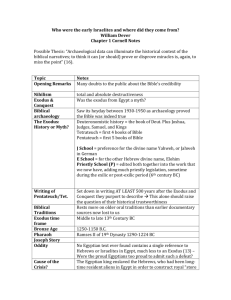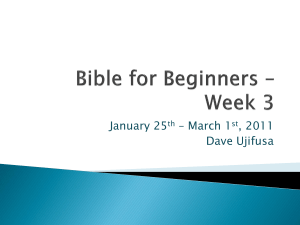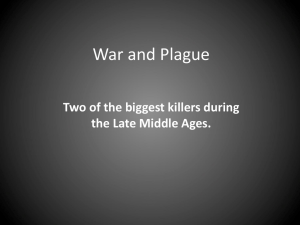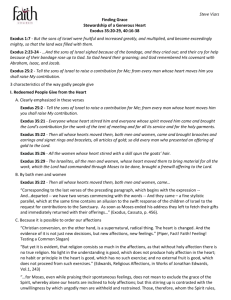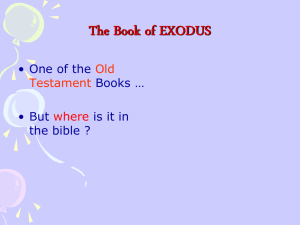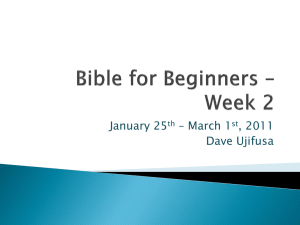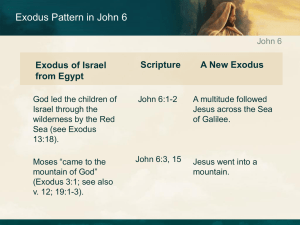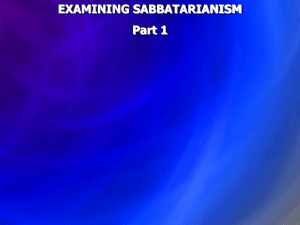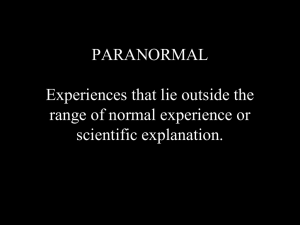PPT12
advertisement
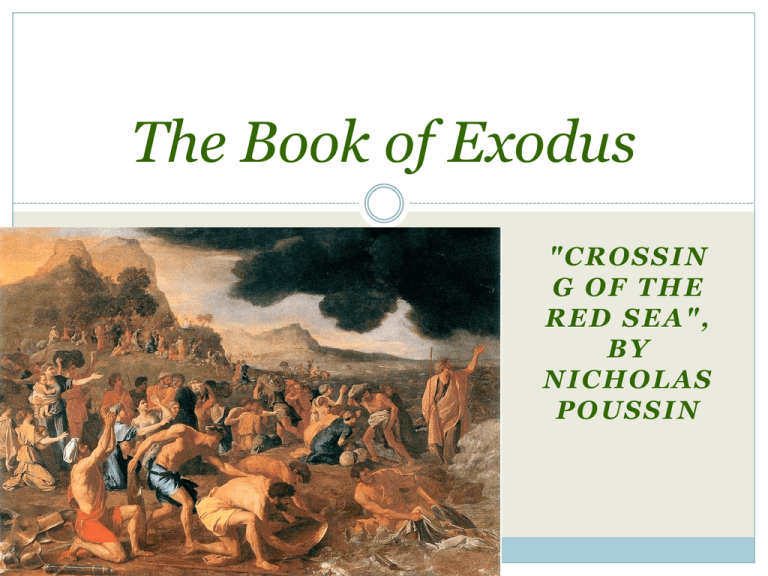
The Book of Exodus "CROSSIN G OF THE RED SEA", BY NICHOLAS POUSSIN 回應前幾週同學的問題 (1): 電影《埃及王子》值得深思的問題還很多。不少同學 都發現一個問題,就是罪與罰的公平性,下面幾則問 題,還有課堂小組報告同學都提到了類似或相關的問 題,這是一個好問題,也是幾千年來西方文學最重要 的主題之一。在此我不直接給同學答案,只是分享一 點我讀《舊約》多年的心得,希望大家一起學習欣賞 這個看似嚴峻,卻總是為人類留後路的「神」,他的 出手用力,但是卻恰到好處。就把這位神視做「父親 」,去想想父親如何養育、管教與教育不同性格的小 孩,可以看見新的倫理美學喔! 回應前幾週同學的問題 (1): 回應前幾週同學的問題 (2): 《埃及王子》心得 出埃及記 3:2 「耶和華的使者從荊棘裡火焰中向摩 西顯現。摩西觀看,不料,荊棘被火燒著,卻沒有燒 毀。」那植物是荊棘或是黑梅… 看到同學用同理心去觀照不同的人,去思考每個人不 同的處境,非常感動。 最難的是放下自己的立場,去體會別人的立場 倫 理美學的思維 衝突,所以需要用智慧解決問題。我們學習站在對方 的角度去看,學習不斷反思! 回應前幾週同學的問題 (3): 自己靠雙腳走,所以人是無所不「行」的! 回應前幾週同學的問題 (4): 亞伯拉罕沒有犧牲小孩, 而是願意拿出最好的,獻 給神。 可以換一個角度思考,我 們是不是願意把自己最好 的東西拿出來,奉獻給社 會?給世界?給別人? 分五個主題介紹出埃及記 Exodus 1. 故事背景 2. 「解放」(deliverance; emancipation) 3. 十災 Ten Plagues 4. 過紅海與曠野 5. 十誡 Ten Commandments 主題一: 故事背景 地理背景 歷史背景 發生時間 (理論一) 公元前1290年是希伯來人出埃及的年份。這是 考古學者推算比東(Pithom)和蘭塞(Ramses, 意即「拉美西斯之城」)兩座積貨城被建造的 年代而得出的,而當時的法老王為古埃及新王 國時期第十九王朝的全盛時代霸主──拉美西 斯二世(蘭塞二世)。持此說的學者認為摩西 的一神教觀念,乃是啟蒙於不久之前在埃及推 行歷史上第一個一神教信仰革命之法老王阿肯 那頓;埃及人是世界上最早擁有一神教觀念的 民族。許多知名電影如《十誡》、《埃及王 子》,都是採信「拉美西斯二世說」。 發生時間 (理論二) 出埃及的年份遠至公元前1445年,這是 根據《列王紀上》第6章第2節參推算出 來的。當時的法老王是古埃及新王國時 期第十八王朝最以尚武著稱,被後世稱 為「埃及的拿破崙」之法老王──圖特 摩斯三世(其後人便是推行一神教信仰 革命的阿肯納頓)。近來,不少學者重 新鑑定考古學的資料… 發生時間 (理論三) 也有一些聖經學者認為,摩西帶領以 色列人離開埃及的時間是公元前1513 年,接獲十誡的時間是公元前1512年。 所根據的時間依據是巴比倫前539年攻 陷耶路撒冷的時間點接合聖經記載產 生的時間線。 The alleged author Traditionally ascribed to Moses himself, modern scholarship sees the book as initially a product of the Babylonian exile (6th century BCE), with final revisions in the Persian post-exilic period (5th century). Main contents tells how the children of Israel leave slavery in Egypt through the strength of Yahweh, the god who has chosen Israel as his people. Led by their prophet Moses they journey through the wilderness to Mount Sinai, where Yahweh promises them the land of Canaan (the "Promised Land") in return for their faithfulness. Israel enters into a covenant with Yahweh who gives them their laws and instructions for the Tabernacle, the means by which he will dwell with them and lead them to the land, and give them peace. 16 神的拯救計畫藉著五個脆弱的女性(兩位接 生婆、摩西的母親與姊姊、法老的女兒)在 默默中進行,保存摩西的性命,讓他成為神 的代言人。 Exodus 大綱 被壓迫者在埃及的生活(1章) 拯救者的預備(2-4章) 耶和華懲罰壓迫選民的法老(5-11章) 逾越節與出埃及(12-14章) 曠野的旅程(15-18章) 在西奈立約(19-24章) 有關崇拜及會幕的指示(25-31章) 盟約的破壞與重定(32-35章) 建造會幕(35-40章) 文本閱讀 19 以色列民族誕生的故事(1-15)。 以色列人在埃及做奴隸受苦,神乃差遣 摩西帶領他們離開埃及,經過大海,得 到新生(14-15)。 以色列人進入曠野,開始了新生後的考 驗(16-18)。 文本閱讀 20 神在西乃山與以色列人立約,頒佈十誡 與律法,做為生活準則(19-24) 神吩咐以色列人建造會幕與聖所,做為 神與他們同在的記號(25-40) 以色列人成為神的子民 回目錄:五個主題 主題二: 「解放」(deliverance; emancipation) 21 拯救以色列人脫離奴役 1) 克服自然界混沌的力量 2) 擊敗壓迫弱小的強權勢力 「解放」(emancipation)的經驗對後 人產生深遠的影響 希伯來經典中,時常回顧出埃及的經歷。 Deliver us! https://www.youtube.com/ Help us now watch?v=3WKN0XF8-3Q With the sting of the whip on my shoulder With the salt of my sweat on my brow Elohim, King God on high Can you hear your people cry: This dark hour... Deliver us Hear our call Deliver us Lord of all Remember us, here in this burning sand Deliver us There's a land you promised us Deliver us to the promised land... More lyrics http://www.allthelyrics.com/lyrics/prince_of_egypt_soundtrack/ofra_haza_eden_ riegel_deliver_us-lyrics-78672.html#ixzz3Lv9mvfjo The theme of emancipation Emancipation is any of various efforts to procuring economic and social rights, political rights or equality, often for a specifically disenfranchised group, or more generally in discussion of such matters. 2. 出埃及記 1-18 內容大要 27 2.1 出 1-18 以色列人在埃及做奴隸:哀嚎(出 1-2) 以色列人受苦的哀嚎喚起神的關心,展開拯 救以色列人的行動(2:24-25): 「阿多(神)乃聽見他們的哀聲,就記念他與 亞伯拉罕、以撒、雅各所立的約。神看顧以 色列人,也知道他們的苦情。」 Exodus 2:3 But when she could hide him no longer, she got a papyrus basket for him and coated it with tar and pitch. Then she placed the child in it and put it among the reeds along the bank of the Nile. 莎草紙 莎草紙(英語:Papyrus)是古埃及人廣泛採 用的書寫介質,它用當時盛產於尼羅河三角 洲的紙莎草的莖製成。大約在公元前3000年, 古埃及人就開始使用莎草紙,並將這種特產 出口到古希臘等古代地中海文明地區,甚至 遙遠的歐洲內陸和西亞。 對古代寫在莎草紙上手稿的研究,或稱為紙 莎草學,是古希臘羅馬歷史學家的基本工具。 古埃及的紙莎草書 神乃呼召摩西向法老鬥法(出 3-12) 31 神乃藉著燃燒的荊棘呼召摩西(3:1-6),接 受艱鉅的使命,挑戰法老的權力,帶領以色 列人離開埃及,得到自由。 liberation 摩西的拒絕 1) 3:11 我是什麼人 2) 3:13 你叫什麼名字? 3) 4:1 他們不信我,也不聽 我 4) 4:10 我是拙口笨舌的人 5) 4:13 你找別人去吧 32 神的回應 1) 3:12 我必與你同在 2) 3:14 我是「自有永有 的」 3) 4:2-9 杖與神蹟 4) 4:12 我必賜你口才 5) 4:14-17 有哥哥做摩西的 口 上帝的救贖 從 1 至 18 章,記載上帝怎樣用祂大能 的手,救贖以色列百姓,領他們出埃 及。 宰殺逾越節的羔羊是這一段的最高峰。 Suffering deliverance, salvation, and redemption 逾越節 (The Feast of Passover or Pesach) - 記念在離開埃及的前一夜,天 使擊殺埃及地所有的長子,卻越 過以色列人的房屋,拯救了以色 列各家。 http://www3.telus.net/public/kstam/tw/temple/det ails/calendar.htm 猶太曆法與節期簡介 36 37 出埃及是不斷的經驗與啟發 38 出埃及的敘述是典範的歷史 (paradigmatic history),容許後來不 同情境中的讀者們,一再地重新閱讀、 吸取靈感。 奴隸 自由 回目錄:五個主題 主題三: 十災 1.血災 2.蛙災 3.虱災 4.蠅災 5.畜疫之災 6. 瘡災 7.雹災 8.蝗災 9.黑暗之災 10.長子之死 災 John Martin’s painting of the plague of hail and fire (1823). Ten Plagues 3.1 Beginning of the curses: Ex. 5:1–9, 7:8–13 3.2 Plague of Blood ( :)דָ םEx. 7:14–25 3.3 Plague of Frogs ( :) ְּצפ ְַּרדֵּ ַַעEx. 7:25–8:11 3.4 Plague of Lice: Ex. 8:16–19 3.5 Plague of Flies ( :)עָרֹובEx. 8:20–32 3.6 Plague of Livestock Death ( :)דֶּ בֶּרEx. 9:1–7 3.7 Plague of Boils ( :)שחִין ְּ Ex. 9:8–12 3.8 Plague of Hail ( :)ב ָָרדEx. 9:13–35 3.9 Plague of Locusts ( :)ַארבֶּה ְּ Ex. 10:1–20 3.10 Plague of Darkness ( :)חֹושֶּךEx. 10:21–29 3.11 Death of the Firstborn ( :) ַמכַתַבְּכֹורֹותEx. 11:1–12:36 The Plague of Frog Plague of Hail 雹災 http://www.bl.uk/learning/cult/insi de/goldhaggadahstories/10plagues/ plaguesofegypt.html The most serious one: the death of the firstborn Lamentations over the Death of the First-Born of Egypt by Charles Pearce (1877) 回目錄:五個主題 主題四: 過紅海/ 曠野四十年 《出埃及記》主要是記載神以全能揀選 摩西為領袖,帶領以色列人離開埃及, 前往應許之地,並在曠野的西乃山和以 色列人立約,頒佈律法。 3.5 解放進入曠野 47 以色列人離開埃及 1) 得到解放 2) 新考驗——曠野 曠野中的以色列 1) 經驗神的同在 2) 接受信仰考驗 曠野成為一個象徵 紅海 紅海(阿拉伯語:البحر األحمر,希伯來語: יַם סּוף,法語:Mer Rouge,英語:Red Sea) 位於非洲東北部與阿拉伯半島之間,呈現狹 長型,長約2250公里,最寬355公里,均深 490米,最深2211米,面積438,000平方公里 。其西北面通過蘇伊士運河與地中海相連, 南面通過曼德海峽與亞丁灣相連。 紅海是印度洋的陸間海,實際是東非大裂谷 的北部延伸。 紅海 紅海是直接由希臘文、拉丁文、阿拉伯文翻 譯過來。雖然紅海在大多數時候並不呈紅色 ,但是偶爾會季節性地出現大片紅色藻類。 這提供了其名稱的一個可能的來源。另一些 學者認為,「紅」來源於其相對於命名者的 方位(許多民族都有以顏色指代方向的傳統 ),指南方或者西方。 另外一些該名稱的可能來源是:附近的紅色 山脈;一個名稱為紅色的本地種族;紅地的 海(古埃及稱沙漠為紅地)等。 以色列人解放得自由(出 13-15) 50 以色列人慶祝逾 越節後,隨即離 開埃及 法老不甘奴隸逃 脫,派兵追捕 在危急時刻,神 以大風分開海水, 讓以色列人到達 對岸 以色列人在曠野流浪(出 16-18) 51 解放之後: 以色列人進入 曠野,缺乏水與 食物,也倍受敵 人威脅。 一再考驗以色列 人對神的信心。 西乃曠野 Chapter 16 Manna The Gathering of the Manna by James Tissot 意為“什麼”;是在古 代以色列人出埃及時, 在40年的曠野生活中, 上帝賜給他們的神奇食 物。 嗎哪 根據《出埃及記》第16章記載,嗎哪出現於以色列人 出埃及後第二個月的15日,當時摩西領以色列人到達 以琳和西乃之間的曠野沒有東西吃,於是以色列人向 摩西抱怨快要餓死。耶和華於是應許摩西將要賜食物 予以色列人。當天晚上,耶和華開始降嗎哪給他們吃 ,從那一天開始,以色列民一連吃了40年,從不間斷 。通常會一連降六天,只是在安息日停降一日,讓百 姓遵守安息日,因此第六天所降的,會是雙倍分量。 頭五天所降的,必須即日吃完,否則留到早上,便會 生蟲變臭;第六天所降的,則可留至第二天也不變壞 。直到約書亞帶領百姓過了約但河,到達迦南地,並 且吃了迦南地的出產之後,才停止降下 嗎哪 嗎哪夜間隨著露水降在營中,是有如白霜的小圓物。 形狀彷佛芫荽子,又好像珍珠,是白色的。以色列人 把嗎哪收起來,或用磨推,或用臼搗,煮在鍋中,又 做成餅,滋味好像新油。 55 以色列人多次抱 怨,甚至希望回 到埃及當奴隸 (15:24; 16:2-3; 17:2-3) 回目錄:五個 主題 主題五 Exodus 19-20 Ten Commandments 在西乃山:頒佈律法與十誡 約/ covenant 出埃及和西乃山的神—人之約是以色列 人最重要的歷史傳統,它記述著以色列 民族和宗教的起源、特質和內涵。 出埃及事件是以色列人被耶和華拯救, 得自由和成為選民身份的歷史記實。此 後以色列人不但在生活中教育其後代體 認這傳統的經過和意義,更在宗教儀式 中如:逾越節等。 Key point The heart of Exodus is the Sinaitic covenant. (在曠野的西乃山和以色列 人立約頒佈律法) 以色列人接受十誡 The social institution 社會結構成形 60 神總是耐心地滿足他們的需要 1) 解決缺水(15:22-27; 17:1-7)及缺 乏食物的問題(16:1-36) 2) 保護他們免於敵人的威脅(17:816)。 摩西的岳父葉特羅幫助建立法律制度,化解 以色列民族內部的危機(18:1-27)。 插曲:出埃及的路線 西乃山的位置 61 The Book of Exodus or, simply, Exodus (from Greek ἔξοδος, exodos, meaning "going out"; Hebrew: שמות,Sh'mot, "Names"), is the second book of the Hebrew Bible, and of the five books of the Torah (the Pentateuch). Ten commandments Ethical Decalogue Exodus 20: 3-6 shall have no other gods before me. 4 “You shall not make for yourself an image in the form of anything in heaven above or on the earth beneath or in the waters below. 5 You shall not bow down to them or worship them; for I, the LORD your God, am a jealous God, punishing the children for the sin of the parents to the third and fourth generation of those who hate me, 6 but showing love to a thousand generations of those who love me and keep my commandments. 3 “You Exodus 20: 7-8 shall not misuse the name of the LORD your God, for the LORD will not hold anyone guiltless who misuses his name. 8 “Remember the Sabbath day by keeping it holy. 9 Six days you shall labor and do all your work, 10 but the seventh day is a sabbath to the LORD your God. On it you shall not do any work, neither you, nor your son or daughter, nor your male or female servant, nor your animals, nor any foreigner residing in your towns. 11 For in six days the LORDmade the heavens and the earth, the sea, and all that is in them, but he rested on the seventh day. Therefore the LORD blessed the Sabbath day and made it holy. 7 “You Exodus 20: 12-17 12 “Honor your father and your mother, so that you may live long in the land the LORD your God is giving you. 13 “ You shall not murder. shall not commit adultery. 15 “You shall not steal. 16 “You shall not give false testimony against your neighbor. 17 “You shall not covet your neighbor’s house. You shall not covet your neighbor’s wife, or his male or female servant, his ox or donkey, or anything that belongs to your neighbor.” 14 “You 十誡的三個版本-和合本譯文 http://zh.wikipedia.org/wiki/%E5%8D%81%E8%AA%A1 Moses with the Ten Commandments, by Rembrandt (1659) Exodus 20: 8 "Remember the Sabbath day by keeping it holy." (NIV) More quotes I have been a stranger in a strange land. Exodus, 2. 22 But I am slow of speech, and of a slow tongue. Exodus, 4. 10 Let my people go. Exodus, 7. 16 Life for life, Eye for eye, tooth for tooth, hand for hand, foot for foot, Burning for burning, wound for wound, stripe for stripe. Exodus, 21. 23 回目錄:五個主題
